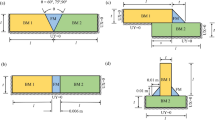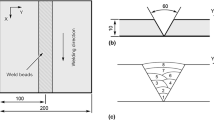Abstract
Numerical modeling of multi-physic manufacturing processes such as welding has been always a complex task when it involves phase changes. In this paper, a finite element model for simulation of the heat transfer, phase transformation, and mechanical analysis of magnetically impelled arc butt welding of low alloy steels is presented. Both effects of volumetric dilatation and transformation-induced plasticity were considered in the mechanical analysis. Series of welded joints were prepared in various welding conditions by using magnetically impelled arc welding machine. Microstructure and residual stresses of a sample were used to verify numerical results. To highlight the importance of volumetric dilatation and transformation-induced plasticity effects, the numerical results were compared with and without the mentioned effects. While without considering phase transformation effects maximum circumferential stresses on weld line reached 260 MPa, consideration of phase volume changes reduced it to − 60 MPa and further consideration of transformation-induced plasticity (TRIP) decreased it to − 70 MPa. On the other hand, the residual stress in the axial direction in this point without considering phase transformation effects was near + 5 MPa while it was near − 90 MPa and − 25 MPa considering just phase volume changes and phase volume changes together with TRIP effects, respectively.
Similar content being viewed by others
References
Dawson JW (1940) Arc welding devices. US Patent 2:280,800
Iordachescu D, Iordachescu M, Georgescu B, Miranda RM, Ruiz-Hervias J, Ocaña JL (2010) Technological windows for MIAB welding of tubes featuring original longitudinal magnetization system with peripheral solenoids. J Mater Process Technol 210:951–960. https://doi.org/10.1016/j.jmatprotec.2010.02.007
Kachinskiy VS, Krivenko VG, Ignatenko VY (2002) Magnetically impelled arc butt welding of hollow and solid parts. Weld World 46:49–56
Vendan SA, Manoharan S, Buvanashekaran G, Nagamani C (2011) Magnetically impelled arc butt welding of alloy steel tubes in boilers—establishment of parameter window. Mechatronics 21:30–37. https://doi.org/10.1016/j.mechatronics.2010.08.001
S.A. Vendan, V. Thangadurai, A. Vasudevan, A.S. Kumar (2014) Investigations on temperature distribution during revolutionary and zigzag movement of arc in magnetically impelled arc butt welding of tubes. 46: 155–163s. doi: 10.3233/JAE-141768
Magnetarc welding, (2017). https://www.kuka.com/en-se/technologies/process-technologies/2016/07/magnetarc-schweissen/ (accessed August 1, 2017).
Norrish J, Cuiuri D, Hossain M (2005) Modelling and simulation of the magnetically impelled arc butt (MIAB) process for transmission pipeline applications, Int. pipeline Integr. Conf. Aust. WITA, Weld. Technol. Insitute Aust, pp 1–7
Panda BN, Vendan SA, Garg A (2016) Experimental- and numerical-based studies for magnetically impelled arc butt welding of T11 chromium alloy tubes. Int J Adv Manuf Technol 88:3499–3506. https://doi.org/10.1007/s00170-016-9057-7
Sivasankari R, Balusamy V, Venkateswaran PR (2015) Characterization of magnetically impelled arc butt welded T11 tubes for high pressure applications. Def Technol 11:244–254. https://doi.org/10.1016/j.dt.2015.03.005
Arungalai Vendan S, Manoharan S, Buvanashekaran G, Nagamani C (2012) Strength assessment using destructive testing on MIAB welded alloy steel tubes and subsequent techno-economical evaluation. J Manuf Process 14:328–335. https://doi.org/10.1016/j.jmapro.2011.12.001
J. Kim, S. Lee, T. ** (2003) Fatigue evaluation of dissimilar welds on nuclear components. Struct Mech React Technol (SMiRT 17) 2–9
Xu M, Chen J, Lu H, Xu J, Yu C, Wei X (2016) Effects of residual stress and grain boundary character on creep cracking in 2.25Cr-1.6W steel. Mater Sci Eng A 659:188–197. https://doi.org/10.1016/j.msea.2016.02.025
API 579-1/ASME FFS-1 (2007) Fitness-for-service, Second Edi, The American society of mechanical Engineers
Silverstein R, Eliezer D (2016) Effects of residual stresses on hydrogen trap** in duplex stainless steels. Mater Sci Eng A 684:64–70. https://doi.org/10.1016/j.msea.2016.12.041
Wan Y, Jiang W, Li J, Sun G (2017) Weld residual stresses in a thick plate considering back chip**: neutron diffraction, contour method and finite element simulation study. Mater Sci Eng A 699:62–70. https://doi.org/10.1016/j.msea.2017.05.079
Song T-K, Kim Y-B, Kim Y-J, Oh C-Y (2014) Prediction of welding residual stress profile in dissimilar metal nozzle butt weld of nuclear power plant. Proc Mater Sci 3:784–789. https://doi.org/10.1016/j.mspro.2014.06.128.
Analysis User Manual (2014) ABAQUS 6.14., Dassault Systèmes, SIMULIA
Brickstad B, Josefson BL (1998) A parametric study of residual stresses in multi-pass butt-welded stainless steel pipes. Int J Press Vessel Pip 75:11–25. https://doi.org/10.1016/S0308-0161(97)00117-8
(2007) The Grades 11 and 12 Low Alloy Steel Handbook: 1¼Cr½Mo, 1Cr½Mo, 13CrMo44, 620/621, STPA 22/23, Electric Power Research Institute
Sedighi M, Mcmahon CA (2000) The influence of quenchant agitation on the heat transfer coefficient and residual stress development in the quenching of steels. IMechE B J Eng Manuf 214:555–567
Avrami M (1939) Kinetics of phase change. I General theory. J Chem Phys 7(12):1103–1112 https://doi.org/10.1063/1.1750380 Abstract
Koistinen DP, Marburger RE (1958) A general equation prescribing the extent of the austenite-martensite transformation in pure iron-carbon alloys and plain carbon steels. Acta Metall 7:59–60
Mahnken R, Schneidt A, Antretter T (2009) Macro modelling and homogenization for transformation induced plasticity of a low-alloy steel. Int J Plast 25:183–204. https://doi.org/10.1016/j.ijplas.2008.03.005
Inoue T (2011) Mechanics and characteristics of transformation plasticity and metallo-thermo-mechanical process simulation. Procedia Eng 10:3793–3798. https://doi.org/10.1016/j.proeng.2011.06.001
Kang SH, Im YT (2007) Thermo-elasto-plastic finite element analysis of quenching process of carbon steel. J Mater Process Technol 192–193:381–390. https://doi.org/10.1016/j.jmatprotec.2007.04.101
Kim J, Im S, Kim HG (2005) Numerical implementation of a thermo-elastic-plastic constitutive equation in consideration of transformation plasticity in welding. Int J Plast 21:1383–1408. https://doi.org/10.1016/j.ijplas.2004.06.007
Geijselaers HJM (2003) Numerical simulation of stresses due to solid state transformations—the simulation of laser hardening. The Netherlands, Hellendoorn
J.B. Leblond, J. Devaux, J.. C. Devaux, Mathematical modelling of transformation plasticity in steels i: case of ideal-plastic phases, Int J Plast 5 (1989) 551–572
Deng D, Murakawa H (2013) Influence of transformation induced plasticity on simulated results of welding residual stress in low temperature transformation steel. Comput Mater Sci 78:55–62. https://doi.org/10.1016/j.commatsci.2013.05.023
Vendan SA, Manoharan S, Nagamani C (2012) MIAB welding of alloy steel tubes in pressure parts: metallurgical characterization and nondestructive testing. Soc Manuf Eng 14:82–88. https://doi.org/10.1016/j.jmapro.2011.09.006
ASTM (2008) E837–08. Standard test method for determining residual stresses by the hole-drilling strain gage method. American Society for Testing and Materials, West Conshohocken
Schajer GS (1988) Measurement of non-uniform residual stresses using the hole-drilling method. Part I—stress calculation procedures. J Eng Mater Technol 110:338. https://doi.org/10.1115/1.3226059
Niku-Lari A, Lu J, Flavenot JF (1985) Measurement of residual-stress distribution by the incremental hole-drilling method. J Mech Work Technol 11:167–188. https://doi.org/10.1016/0378-3804(85)90023-3
Aoh J-N, Wei C-S (2003) On the improvement of calibration coefficients for hole-drilling integral method: part II—experimental validation of calibration coefficients. J Eng Mater Technol 125:107. https://doi.org/10.1115/1.1543972
Author information
Authors and Affiliations
Corresponding author
Additional information
Highlights
• Numerical model for simulation of residual stress and phase transformation effects for magnetically impelled arc butt welding of a low alloy steel was developed.
• Experimental validation of the numerical simulation was performed.
• Simplified approach for modeling transformation-induced plasticity was presented.
Electronic supplementary material
ESM 1
(FOR 24 kb)
Rights and permissions
About this article
Cite this article
Mosayebnezhad, J., Sedighi, M. Numerical and experimental investigation of residual stresses in magnetically impelled arc butt welded joints in low alloy steels. Int J Adv Manuf Technol 96, 4501–4515 (2018). https://doi.org/10.1007/s00170-018-1865-5
Received:
Accepted:
Published:
Issue Date:
DOI: https://doi.org/10.1007/s00170-018-1865-5




